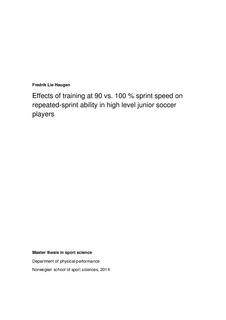Effects of training at 90 vs. 100 % sprint speed on repeated-sprint ability in high level junior soccer players
Master thesis
Permanent lenke
http://hdl.handle.net/11250/226442Utgivelsesdato
2014Metadata
Vis full innførselSamlinger
Sammendrag
Background: Repeated sprint ability (RSA) is one of many important determinants for
optimal performance in soccer. In the later years, several training studies have examined
how to improve this parameter for gaining an optimal performance on the court. No
studies have before examined the effect of training at lower intensities. Thus, the aim of
this study was to examine if there were any improvements in RSA when training
repeated sprint once in a week for seven weeks on different intensities and if the
improvements on RSA were the same when training on lower intensity.
Methods: 41 well-trained male soccer players of age (±SD) 16.7 (± 1.0) years, body
mass 71.1 (± 9.4) kg, and stature 181.2 (±6.1) cm participated in the study. They were
randomized either to the 100 % intensity group (100 % group) (n=16), the 90 %
intensity group (90 % group) (n=15) or the control group (CON) (n=10). In addition to
normal training, the 100 % group and the 90 % group completed 1 repeated sprint
training session per week for a total of 7 weeks. The 100 % group performed 15 laps
(20 meters) on 100 % intensity with one minute breaks between them. The 90 % group
performed 30 laps (20 meters) on 90 % intensity with one minute between them. Before
and after intervention, performance was assessed by a repeated 20 m *15shuttle sprint
ability test, where mean and best times were measured. A yo-yo intermittent recovery
test (IR1) and counter movement jump (CMJ) test was also conducted.
Results: Within-group results showed statistical improvements for 100 % group in
steplength (SL), step frequency (SF) and lactate. Between-group differences showed no
statistically marked improvements for 100 % group or 90 % group against CON in any
of the parameters. The effect of the training was only trivial to small in the performance
parameters.
Conclusion: Taking the results in this study into consideration, it can’t be
recommended to train 20 meter repeated sprint for gaining improvements in RSA for
young high level soccer players. Other training methods could be preferred for gaining
improvements even though genetics probably are most important in terms of sprinting
ability. There is a need of more studies were a higher extent of individualization is
made.
Beskrivelse
Masteroppgave - Norges idrettshøgskole, 2014
